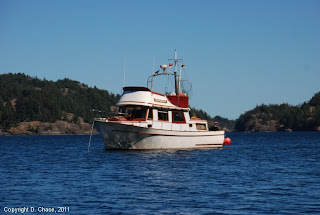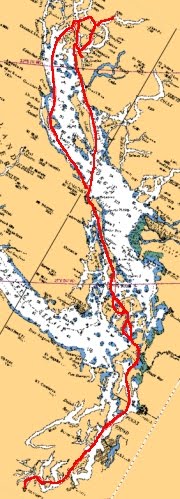 |
| Quiet before the storm. Looking SW. |
 |
| Click on image to enlarge |
I double checked my anchor setting and made careful mental note of objects on shore that would tell me if I had dragged anchor. I also made note of the boats around me and how they were anchored. There were two fish boats (trollers) anchored west of me, a 40' Chris Craft southwest of me, and a couple of small sailboats anchored north of me. To the east of of me there were many other cruising boats but they didn't worry me. The Chris Craft worried me, because I noticed he just dropped his anchor without setting it; he used a Danforth anchor; and he had no chain rode, just rope.
Initially this evening the mosquitoes were numerous and nasty and all of a sudden they just disappeared. I knew I hadn't killed them all, but it was strange that they all disappeared. Did they know something I didn't? As we went to bed around 2130, the waters were glassy calm and the air was very still. At about 2330 I noticed the boat quickly swing about at anchor and a light rain hitting the cabin roof. Suddenly a gust hit the boat, I heard the anchor line strain, and now a torrent of rain hit the boat. What was calm was now very noisy. This had all come so suddenly, the forecast thunder storm was now upon us. The wind roared through the trees, the rain pounded the water and the boat, and lightning lit up the anchorage. Incredibly there were one foot waves in this sheltered anchorage. I looked out the windows to see the Chris Craft moving east as if he was under power but he wasn't, he was dragging anchor. Fortunately he dragged just behind me. Folks in the small sailboats had their motors going and were checking their anchors. I was still holding fine. Lightning lit up the anchorage repeatedly to give you a quick look at the chaos about. The Chris Craft now had his motor going and you could hear yelling in the distance over the roar of the wind and thunder between him and a couple of boats. I was safe. The wind and rain continued for about 45 minutes and then started to calm down and I returned to my bunk.
 |
| Morning after the storm at Crease Is. Cove. Looking NE. |
We've returned to Crease Island Cove many times since that night. It remains one of our most favorite anchorages on the BC Coast. We very much enjoy cruising about and exploring the many small islands in our dinghy. They're great for a nap, reading a book, or a picnic. But, be careful there's black bears about. I've got a great picture of my brother sitting on shore reading a book not knowing there was a black bear not more than 30' away from him. He never knew until I told him later and showed him the picture. Often times we have seen bears swimming from island to island, along with other animals - otters and raccoons. We've seen orca and white-sided dolphins in Blackfish Sound and Knight Inlet. There's great scuba diving too along these islands. (To learn more visit www.sunfundivers.com or Sunfun Divers on Facebook) There's great salmon fishing nearby in Blackfish Sound. Excellent prawning and crabbing nearby too. Port McNeill is about 19 nautical miles away where you can stock up on provisions. Or, you can easily wind your way through the islands to Echo Bay (~8 nm), just be careful of the currents and many shoals. Being right at the southern tip of Queen Charlotte Strait and just by Johnstone Strait, Crease Island Cove is a great "jumping off" point for the trip home or for points further north.
Happy New Year! May 2012 be a year filled with many safe and happy adventures.







